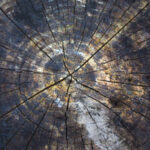Have you ever been forced to saw down a tree in your yard? The tree might have been dead, or downed by a severe storm or high winds. Once the tree is down, you will have to decide what to do with the remaining stump and roots.
Tree stump removal can be costly and time consuming. The easiest and cheapest method is to cover the stump with a plant. You could also conceal the tree stump by growing a shrub in front of it.
A third option is the method I used for concealing an ugly tree stump is my own yard. Hiding a tree stump with a rock perimeter flower bed is easy to do, inexpensive, and makes an attractive addition to your yard. I was also able to resolve other landscaping problems with this tree stump concealing solution. You may find hiding a tree stump is the easiest way to solve a tree stump dilemma.
First, I should mention that the tree stump in my front yard was on a sloped incline. It had been cut fairly close to the ground and had large tree roots sticking out of the ground in several places. Not only were the tree stump and roots unattractive, they made the slope in my front yard difficult to mow. If you should decide to hide a tree stump with this rock-perimeter flower bed method, ensure the tree stump is first sawed off as close to the ground as possible.
new vegetable garden. The ground was extremely rocky and had never been tilled before. After the ground was tilled, I discovered numerous unwanted rocks in the garden bed. I picked up buckets of rocks and didn’t know what to do with them. That’s when I spied the tree stump and devised this tree stump landscaping solution.
My goal was to attractively conceal the tree stump and tree roots, decrease the slope in the front yard, and find a new home for all the rocks I was removing from my new gardening spot.
First, I took a 6 ft. piece of rope and tied a small wooden garden stake to each end. I planned a 12 ft. diameter flower bed to hide my tree stump and tree roots. Your own size will vary depending on how large a space you need to conceal your tree stump and any roots.
Next, I hammered the first stake into the ground marking the center of my new flower bed. I stretched the rope and used the stake at the opposite end like a giant compass to mark an outside line for the perimeter edge of my flower bed.
Part of the goal in hiding my tree stump and tree roots included diminishing the slope in my yard. I placed the outside perimeter line for my new flower bed over the top of the tree stump to accomplish this. I would cover the stump with large flat rocks later.
Consider your own landscaping goals when determining best placement for concealing a tree stump. I arranged larger sized rocks along the outer perimeter of my soon-to-be flower bed. I carefully placed them along the outside perimeter previously marked with the stick. The outside perimeter was lined with rocks already collected from my garden. I wanted to help level out my sloped area so I put larger rocks on the shallow side of the slope and used flatter ones on top of the stump and along that steeper side of the perimeter. Later, I would use potting soil to help level the two sides and reduce the slope.
Next, while still leaving the first stake firmly planted in the center of the stone circle, I untied the rope from the outside stake. I measured 2 ft. from the end of the rope and retied the stake 2 ft. closer to the inside stake. The staked rope is now 4 ft. long. I used it to make another smaller circle 2 ft. in from the first circle of perimeter rocks. Again, I used larger rocks to mark the boundary along the edge of the smaller 8 ft. diameter circle.
Use landscaping fabric as needed to cover the ground between these two circles. Next, cover the landscaping fabric with smaller rocks. Arrange them as necessary to stay within the boundaries of the large rock borders. The landscaping fabric will help keep weeds from growing through the rocks. Then use several layers of smaller rocks as needed to build up a firm rock perimeter around the 8 ft. circular flower bed in the center.
Once you have a nice firm rock perimeter to conceal your tree stump and any exposed tree roots, it’s time to make the circular flower bed. My center circle needed more soil to cover the large tree roots. I also wanted to build up a deeper flower bed to help ease the sloping incline so I purchased several large bags of good quality potting soil. I personally recommend using Miracle-Gro® Moisture Control Potting Mix
Miracle-Gro® Moisture Control Potting Mix may be a little more expensive than other brands of potting mix, but I have gotten consistently better results. Miracle-Gro® Moisture Control Potting Mix contains timed release Miracle-Gro® fertilizer and also AquaCoir. ®
The AquaCoir® really does make the difference. I think it contributes significantly to Miracle-Gro® Moisture Control’s superior performance. AquaCoir® is a unique blend of coconut fibers, sphagnum peat moss and a wetting agent. This special blend absorbs excess water and releases it gradually as your plants need it to help prevent over or under watering. This is extremely helpful to plants with owners that periodically forget to water them. While Miracle-Gro® Moisture Control is primarily an indoor potting mix, I use it for all my outdoor potted plants and as an additional boost to my flower beds.
You can find Scott’s brand Miracle-Gro® Moisture Control Potting Mix at your local gardening center or find more information about their products at this link http://www.scotts.com/smg/home/home.jsp.
I then planted flowers in my circular flower bed. It completely conceals the ugly tree stump and the tree’s roots. You could do the same with a tree stump in your yard. The picture accompanying this article shows the circular flower bed I made to hide my tree stump. I included it to inspire others who may be looking for creative ways to hide their own ugly tree stump.
Happy gardening and good luck with those tree stumps!




